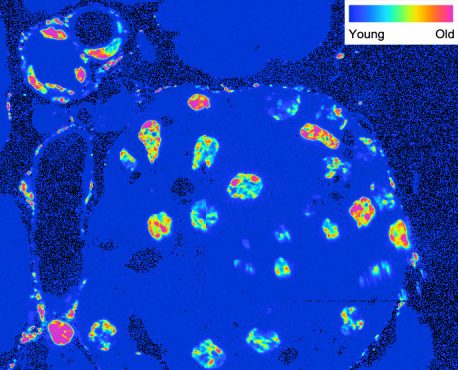
They used to think that all cells other than brain cells would simply be replaced:
“We were quite surprised to find cellular structures that are essentially as old as the organism they reside in,” says Salk Vice President, Chief Science Officer Martin Hetzer, senior author and professor. “This suggests even greater cellular complexity than we previously imagined and has intriguing implications for how we think about the aging of organs, such as the brain, heart and pancreas.”
Most neurons in the brain do not divide during adulthood and thus experience a long lifespan and age-related decline. Yet, largely due to technical limitations, the lifespan of cells outside of the brain was difficult to determine.
Isotope imaging of different cells inside an islet of Langerhans within the pancreas. Older cells have a yellow-to-pink color scheme, while younger cells exhibit a blue-to-green color pattern. Isotope imaging of different cells inside an islet of Langerhans within the pancreas. Older cells have a yellow-to-pink color scheme, while younger cells exhibit a blue-to-green color pattern. Click here for a high-resolution image.
“Biologists have asked—how old are cells in an organism? There is this general idea that neurons are old, while other cells in the body are relatively young and regenerate throughout the organism’s lifetime,” says Rafael Arrojo e Drigo, first author and Salk staff scientist. “We set out to see if it was possible that certain organs also have cells that were as long-lived as neurons in the brain.”
Since the researchers knew that most neurons are not replaced during the lifespan, they used them as an “age baseline” to compare other non-dividing cells. The team combined electron isotope labeling with a hybrid imaging method (MIMS-EM) to visualize and quantify cell and protein age and turnover in the brain, pancreas and liver in young and old rodent models.
To validate their method, the scientists first determined the age of the neurons, and found that—as suspected—they were as old as the organism. Yet, surprisingly, the cells that line blood vessels, called endothelial cells, were also as old as neurons. This means that some non-neuronal cells do not replicate or replace themselves throughout the lifespan …
Prior studies have suggested that the liver has the capacity to regenerate during adulthood, so the researchers selected this organ expecting to observe relatively young liver cells. To their surprise, the vast majority of liver cells in healthy adult mice were found to be as old as the animal, while cells that line blood vessels, and stellate-like cells, another liver cell type, were much shorter lived. Thus, unexpectedly, the liver also demonstrated age mosaicism, which points to potential new paths of regenerative research for this organ. “How old are your organs? To scientists’ surprise, organs are a mix of young and old cells” at Salk News
If the vast majority of liver cells are as old as the animal, being kind to the liver may be a key to longevity. It will be interesting to see whether epigenetic changes affect new cells or old cells more.
Hat tip: Philip Cunningham
See also: Researchers: How The Immune System “Thinks”
Researcher: Mathematics Sheds Light On “Unfathomably Complex” Cellular Thinking
How do cells in the body know where they are supposed to be?
Follow UD News at Twitter!